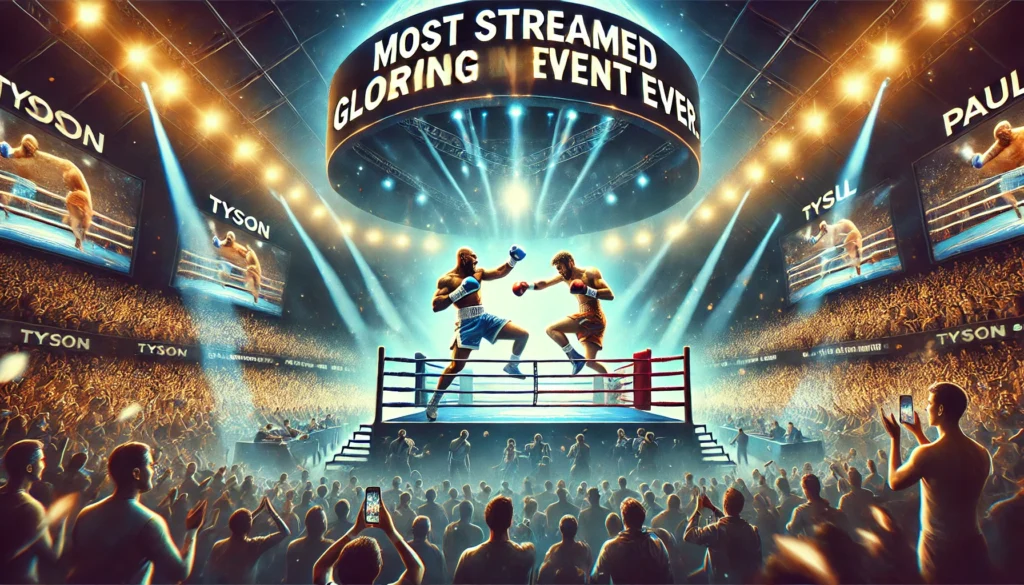
The announcement by Netflix that the Tyson-Paul fight has become the “most streamed global sporting event ever” is more than a headline—it’s a seismic moment for sports, streaming, and entertainment. This statement marks a tipping point in how audiences engage with live sports and the intersection of celebrity culture, digital platforms, and global reach. The Tyson-Paul bout wasn’t just about boxing—it was about a cultural phenomenon that extended far beyond the ring. This blog unpacks the factors that propelled this event to unparalleled streaming success and what it means for the future of sports broadcasting.
The Unlikely Matchup: A Perfect Storm
The clash between Mike Tyson, the heavyweight legend, and Logan Paul, the social media juggernaut, was far from a traditional boxing match. It was a spectacle engineered for maximum global appeal, combining nostalgia with contemporary internet culture. Tyson, revered as one of the greatest boxers of all time, brought with him a legacy that transcends sports. Paul, with his massive YouTube following and controversial yet captivating persona, represented a younger, digitally savvy audience.
This fusion of old-school boxing prestige and influencer-driven hype created a cultural event that appealed to a multi-generational audience. For older fans, it was an opportunity to see Tyson back in the ring. For younger viewers, it was a chance to see their digital idol face off against a legend. This generational bridge was a masterstroke in audience engagement.
Netflix’s Entry into Live Sports
Netflix’s decision to stream the fight marked its first foray into live sports, a move that had been anticipated for years. Historically, Netflix has shied away from live events, focusing instead on on-demand content. However, the Tyson-Paul fight offered the perfect opportunity to test the waters.
The platform’s unparalleled global reach—over 230 million subscribers in 190 countries—ensured that the event would be accessible to a massive audience. Netflix also brought its expertise in content recommendation and personalized marketing to the table, ensuring that the fight reached the right viewers at the right time.
This shift signals a new chapter for Netflix, as it positions itself as a competitor not only to traditional broadcasters like ESPN and Sky Sports but also to other streaming platforms like Amazon Prime Video and Apple TV+, both of which have been investing heavily in sports rights.
The Hype Machine: Marketing and Social Media Buzz
The lead-up to the fight was a case study in modern marketing. Both Tyson and Paul leveraged their massive social media followings to build anticipation. Paul’s YouTube videos chronicling his training and promotional stunts generated millions of views, while Tyson’s nostalgic throwbacks to his prime reignited interest in his storied career.
Netflix supplemented this organic buzz with a high-profile marketing campaign. Trailers, behind-the-scenes footage, and exclusive interviews flooded social media, creating a sense of urgency and FOMO (fear of missing out). Additionally, the platform’s integration of promotional content into its homepage ensured that even casual viewers were aware of the event.
Collaborations with brands and influencers further amplified the hype. Merchandise drops, betting promotions, and viral challenges tied to the fight ensured that it permeated pop culture. The marketing strategy was not just about promoting the fight; it was about creating an event that felt like a must-watch moment in history.
Breaking Streaming Records: Why This Fight Went Viral
Netflix’s claim of the Tyson-Paul fight as the “most streamed global sporting event ever” is backed by several factors that made it uniquely positioned to achieve this milestone:
1.Global Accessibility
Unlike traditional pay-per-view (PPV) events, which are often regionally restricted or expensive, Netflix’s subscription model made the fight accessible to a worldwide audience at no extra cost. This democratization of access was a game-changer.
2.Multi-Device Streaming
The ability to watch on any device—smart TVs, laptops, tablets, or smartphones—meant that viewers could tune in from anywhere. This flexibility was particularly crucial for younger audiences, who are more likely to stream content on mobile devices.
3.Cross-Demographic Appeal
The fight’s blend of nostalgia and modernity attracted a diverse audience. It wasn’t just boxing fans or YouTube followers watching; it was families, casual sports viewers, and even those drawn in by the cultural buzz.
4.Peak Timing
The event was strategically scheduled to maximize global viewership. By selecting a time that catered to audiences across multiple time zones, Netflix ensured that fans from Los Angeles to London to Tokyo could tune in live.
5.Social Media Integration
The fight dominated social media platforms, with real-time reactions, memes, and live tweets enhancing the viewing experience. This second-screen engagement created a communal atmosphere that made the event feel larger than life.
Critics and Controversies: Is It Really Sport?
Despite its success, the fight has faced its share of criticism. Purists argue that bouts like Tyson-Paul dilute the essence of boxing, turning it into a spectacle rather than a sport. The inclusion of celebrity influencers has sparked debates about whether such events should be classified as legitimate athletic competitions or entertainment products.
However, this criticism misses the point. The Tyson-Paul fight was never meant to appeal solely to hardcore boxing fans. It was a cultural moment that embraced the evolving nature of sports as entertainment. In an era where attention spans are short and content is king, the ability to draw millions of viewers—regardless of their motivations—speaks volumes about the fight’s impact.
The Future of Sports Broadcasting
The success of the Tyson-Paul fight has far-reaching implications for the sports broadcasting industry. Traditional PPV models, which have dominated boxing for decades, are now being challenged by subscription-based platforms. The fight demonstrated that streaming services like Netflix can deliver live events on a scale previously thought impossible.
This shift could lead to a new era of sports broadcasting, where global accessibility, affordability, and cross-platform integration become the norm. It also raises questions about the future of traditional sports rights deals. Will Netflix begin bidding for major league contracts, like the NFL or the Premier League? If so, the landscape of sports broadcasting could change dramatically in the coming years.
A New Era for Sports and Streaming
The Tyson-Paul fight was more than just a sporting event—it was a cultural phenomenon that redefined what live sports can look like in the streaming age. By leveraging the star power of its participants, the global reach of Netflix, and the power of social media, it achieved unprecedented success.
As Netflix celebrates this milestone, the industry as a whole must reckon with the implications. The line between sports and entertainment is becoming increasingly blurred, and the rise of streaming platforms is challenging traditional broadcasting models. Whether you view the Tyson-Paul fight as a legitimate athletic competition or a pop culture spectacle, there’s no denying its significance in shaping the future of sports and entertainment.
In the end, the fight wasn’t just about who won or lost—it was about how an event can capture the imagination of a global audience in the digital age. And in that sense, the Tyson-Paul fight was a knockout.
No comments yet.








